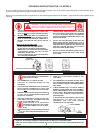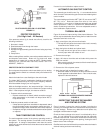
22
PREVENTIVE MAINTENANCE
RECOMMENDED PROCEDURE FOR PERIODIC
REMOVAL OF LIME DEPOSITS FROM COIL
TYPE COMMERCIAL WATER HEATERS
The amount of calcium carbonate (lime) released from water is in
direct proportion to water temperature and usage, see fig. 17.
CAUTION
DO NOT USE A NYLON BRUSH OR OTHER STATIC CREATING
MATERIAL TO CLEAN DUST AND CARBON DEPOSITS FROM
HEATING SURFACES AND VENT.
SUCH DEPOSITS ARE FLAMMABLE AND MAY BE IGNITED
BY STATIC ELECTRICITY. USE A METAL BRUSH TO MINIMIZE
THE DANGER OF EXPLOSION.
1. Turn off the electrical power and main manual gas shutoff valve.
• Allow heater parts and vent to cool before disassembly.
2. Remove the heater draft diverter and vent pipe running to the
chimney.
• Check parts and chimney for obstructions and clean as
necessary.
• Replace any damaged or deteriorated parts of the venting
system.
3. Remove burners from heater and other metal parts as required
to clean and vacuum the heat exchangers and combustion
coils.
• Refer to parts list supplied with this manual for disassembly
aid.
4. Reinstall the parts removed in steps 2 and 3.
• Be sure the vent pipe has a minimum upward pitch of one
quarter inch per foot of length and is sealed as necessary.
5. Restore electrical power and gas supply to heater.
• Check for gas leaks and proper heater and vent operation.
Upon reassembly, a negative draft must be produced by the
system. Check for proper draft by holding a lit match near the
draft hood opening while the heater is operating. The flame should
be drawn into the draft hood opening indicating proper draft.
GAS PRESSURE REGULATOR
The gas pressure regulator is included in the combination gas
valve, fig.14, and is set to operate on the gas specified on the
heater model and rating plate.
Periodically check main burner, fig. 13, and pilot flame, fig. 15, for
proper operation. This should be checked every six months.
Do not subject the gas valve to inlet gas pressure of more than
10.5" W.C. - natural gas, 13.0" W.C. - propane gas. If higher gas
pressures are encountered, a service regulator is necessary.
Check for a minimum inlet gas pressure value shown on the Rating
Plate before making any adjustment of the regulator.
Attempts to adjust the regulator during periods of low gas supply
pressure could result in overfiring of the heater when the gas
supply pressure returns to normal.
DO NOT INCREASE PRESSURE ABOVE THAT SPECIFIED AS
OVERFIRING WILL RESULT IN DAMAGE TO THE HEATER
.
If gas pressure regulator cannot be adjusted to correct pressure
with sufficient gas pressure at the valve, replace with new gas
valve.
RELIEF VALVE
At least twice a year the system relief valves should be checked
to ensure that they are in operating condition. To check a relief
valve, lift the lever at the end of the valve several times. The
valve should seat properly and operate freely.
CAUTION
BEFORE MANUALLY OPERATING A RELIEF VALVE, MAKE
SURE THAT A DRAIN LINE HAS BEEN ATTACHED TO THE
VALVE TO DIRECT DISCHARGE TO AN OPEN DRAIN.
FAILURE TO TAKE THIS PRECAUTION COULD MEAN
CONTACT WITH EXTREMELY HOT WATER EXITING THE
VALVE DURING THE CHECK OPERATION.
If a relief valve discharges periodically or continuously, it may be
due to thermal expansion of water in a closed water supply system,
or, it may be due to a faulty relief valve.
Thermal expansion is the normal response of water when it is
heated. In a closed system, thermal expansion will cause the
system pressure to build until the relief valve actuation pressure
is equaled. Then the relief valve will open allowing some water to
escape, slightly lowering the pressure.
Installation of a properly sized thermal expansion tank will usually
correct this problem. Contact your water supplier or local plumbing
inspector for information on how to best correct this situation.
ABOVE ALL DO NOT PLUG ANY RELIEF VALVE. THIS IS NOT
A SOLUTION AND CAN CREATE A HAZARDOUS SITUATION.
CIRCULATING PUMP
The circulating pump may require occasional lubrication. Refer
to circulator manufacturer’s instructions for lubrication procedures,
and lubrication frequency.
ELECTRICAL SERVICE
CAUTION
LABEL ALL WIRES PRIOR TO DISCONNECTION WHEN
SERVICING CONTROLS. WIRING ERRORS CAN CAUSE
IMPROPER AND DANGEROUS OPERATION.
VERIFY PROPER OPERATION AFTER SERVICING.
REPLACEMENT PARTS
Replacement parts may be ordered through A. O. Smith dealers,
authorized servicers or distributors. Refer to the Yellow Pages
for where to call or contact the A. O. Smith Water Products
Company, 5621 West 115th Street, Alsip, IL 60803,
1-800-433-2545, or on the web at www.hotwater.com/parts. When
ordering parts be sure to state the quantity, part number and
description of the item including the complete model and serial
number as it appears on the product. Refer to the parts list for
more information.
The higher the water temperature or water usage, the more lime
deposits are dropped out of the water. This is the lime scale
which forms in pipes, heaters and on cooking utensils.
Lime accumulation not only reduces the life of the equipment,
but also reduces efficiency of the heater and increases fuel
consumption.


















